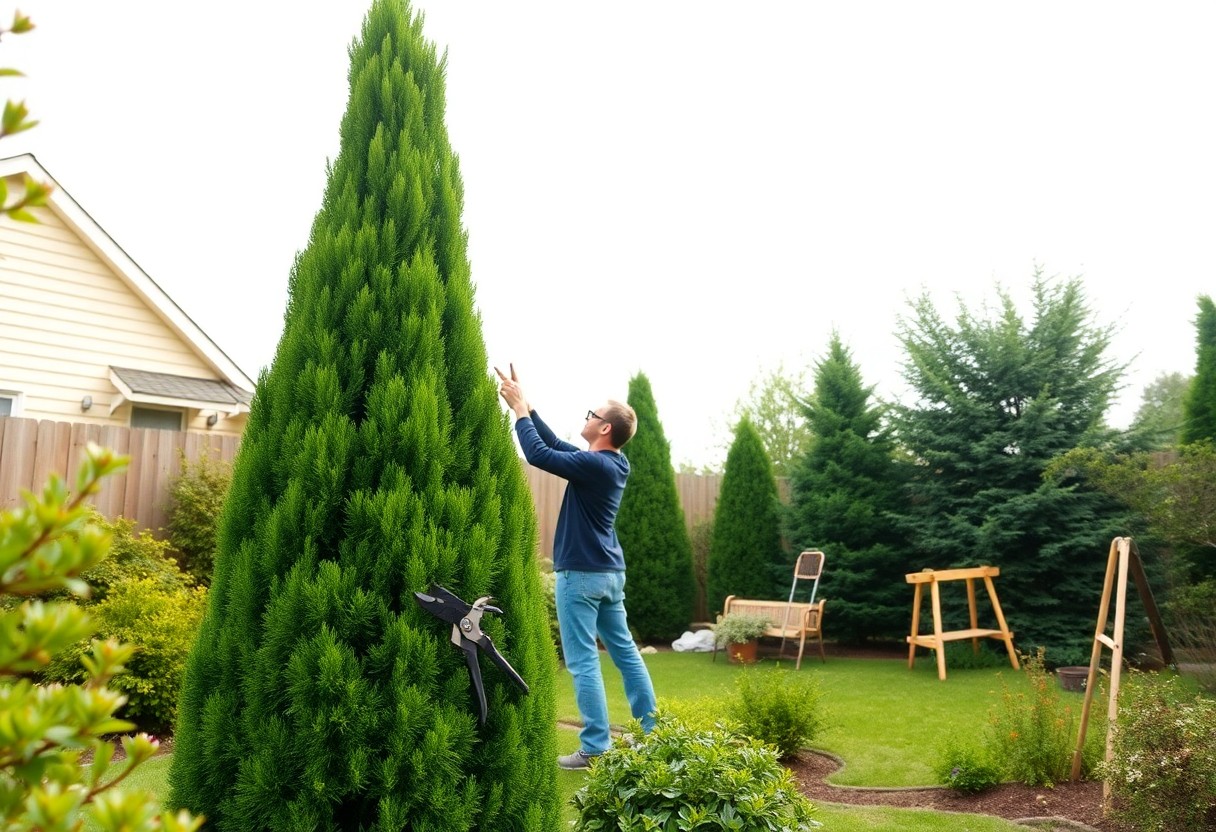
This guide will help you tackle your overgrown arborvitae, making it the perfect shape for your landscape. With just a few simple techniques, you can bring your tree back into a manageable size while promoting healthy growth. Whether your arborvitae has gotten a bit too tall or wide, you’ll find easy-to-follow steps here to get it looking neat and tidy in no time. Let’s dive in and get your greenery back under control!
Understanding Arborvitae
To maintain a beautiful landscape, it’s crucial to understand the unique qualities of arborvitae. These evergreen plants are popular for their dense foliage and ability to thrive in various climates. They can grow tall and wide, making them a favorite choice for hedges, privacy screens, and ornamental features. Knowing their growth habits will help you care for your arborvitae effectively, ensuring they fit well into your outdoor space.
Characteristics of Arborvitae
Little did you know, arborvitae are characterized by their lush, scale-like leaves and upright growth. With various species available, these trees can range from small, compact varieties to tall, majestic forms. Their vibrant green hue can transform into shades of gold or bronze during colder months, adding seasonal interest to your garden. Additionally, they are relatively low-maintenance, making them an ideal choice for busy gardeners.
Common Reasons for Pruning
You might wonder when it’s appropriate to prune your arborvitae. Common reasons for pruning include controlling the size and shape, promoting healthier growth, and removing any dead or damaged branches. Pruning can help ensure that your tree remains a beautiful feature in your yard while also preventing overcrowding that can lead to disease.
A well-timed pruning can enhance your arborvitae’s overall health and aesthetics. If your tree has outgrown its spot or is blocking light from other plants, a trim can help maintain its ideal height and width. Pruning also encourages new growth, allowing your arborvitae to remain lush and vibrant. By addressing any dead or weak branches, you improve airflow through the foliage, further protecting the tree from pests and diseases.
When to Prune Your Arborvitae
It is best to prune your arborvitae during early spring or late summer. Pruning at these times encourages healthy growth and allows the plant to recover quickly. Avoid pruning in late fall or winter, as this can expose your arborvitae to cold weather damage and hinder its ability to thrive throughout the seasons.
Ideal Timing for Pruning
Even though arborvitae can handle some year-round grooming, early spring before new growth begins is ideal for a more significant pruning. This timing ensures that your plant has plenty of time to grow back before winter sets in.
Signs Your Arborvitae Needs Pruning
Now that you’ve got the timing down, let’s look for signs that your arborvitae is ready for a trim. Look for overgrown branches, dead or yellowing foliage, or a loss of shape—these are all clues that your plant needs some attention.
Needs can manifest in several ways, such as dense growth that makes your arborvitae look unkempt or branches starting to shade out lower parts. Additionally, if you notice branches crossing each other, this can cause damage over time. Regular pruning will help maintain your arborvitae’s health, shape, and beauty throughout the seasons.
Tools You’ll Need
Even if pruning might seem like a simple task, having the right tools makes all the difference in achieving good results. To make your job easier, gather crucial tools like bypass pruners, loppers, and a pruning saw. Additionally, consider having a pair of gloves and a ladder handy if your arborvitae is particularly tall. Being prepared will help the process go smoothly and safely, leaving your greenery looking great!
Essential Pruning Tools
Essential pruning tools include bypass pruners for small branches, loppers for those thicker ones, and a pruning saw for tackling larger limbs. With these tools, you can easily shape your arborvitae, keeping it healthy and attractive. A sturdy ladder might be needed if your tree grows quite tall, so ensure you have that ready too. Investing in quality tools will make the task enjoyable!
Safety Gear for Pruning
Assuming you’re ready to prune, safety gear is just as important as your tools. Investing in a good pair of gloves protects your hands from sharp branches and thorns. Safety goggles are crucial to shield your eyes from falling debris, and sturdy shoes will help you keep your footing while on a ladder. It’s best to prioritize your safety as you create a beautiful shape for your arborvitae.
Pruning your arborvitae can be a rewarding experience, but safety should always come first. By wearing gloves, you shield your hands from cuts and scrapes, ensuring your comfort during the task. Safety goggles prevent any dust or debris from irritating your eyes, while sturdy shoes provide a solid grip as you work. Taking these precautions allows you to focus on the pruning itself, knowing you’re protected while you create the perfect shape for your tree.
Step-by-Step Pruning Guide
For a successful pruning experience, follow this step-by-step guide to ensure your arborvitae stays healthy and looks great.
| Step | Description |
|---|---|
| 1 | Assess the Plant |
| 2 | Gather Tools |
| 3 | Start Pruning |
| 4 | Clean Up |
Preparing for the Pruning Process
With the right preparation, pruning becomes an enjoyable task. Begin by assessing your arborvitae’s overall shape and height to determine how much you want to trim back. Next, gather your tools such as sharp pruning shears, loppers, and gloves to ensure you have everything you need at hand. Finally, check the weather; a mild day with dry conditions is ideal for pruning.
Pruning Techniques to Use
Pruning involves more than just cutting; it requires specific techniques to achieve the desired outcome. You can use a combination of thinning and shaping cuts to help maintain an even appearance.
A good technique is to thin the inner foliage to allow more light and air to reach the lower branches. This helps promote healthy growth. Additionally, use shaping cuts on the outer branches to create a fuller look and maintain a natural form. Ensure you make clean cuts at a slight angle to promote healing and reduce the risk of diseases affecting your arborvitae.
Tips for Maintaining Arborvitae Shape
Once again, keeping your arborvitae looking vibrant and well-shaped requires some ongoing effort. Here are a few tips to help you maintain the best shape for your trees:
- Regularly inspect for dead or damaged branches.
- Trim to encourage denser growth and reduce width.
- Avoid cutting too close to the trunk to prevent browning.
The key is to be proactive in your pruning and care.
Regular Maintenance Tips
Even small efforts in your maintenance can go a long way. Here are some effective tips to keep your arborvitae healthy and vibrant:
- Water deeply but infrequently, especially during dry spells.
- Fertilize during the spring to promote strong growth.
- Keep mulch around the base to retain moisture.
Recognizing the signs of stress can help you take action early.
Seasonal Care Recommendations
Any time of year presents an opportunity to care for your arborvitae. Different seasons bring various tasks to keep your trees thriving. During spring, focus on pruning and fertilizing. In summer, ensure adequate hydration during dry spells. Fall is an excellent time for establishing thicker mulch layers. Winter gives you a break, but be mindful of heavy snow that can weigh down branches.
To keep your arborvitae in peak condition, adjust your care routine according to seasonal changes. In the spring, you’ll want to prune to shape and fertilize for growth. Summer requires regular watering, especially during hot spells, while fall is perfect for applying mulch to insulate the roots. During winter, stay vigilant for snow buildup, as it can weigh down branches and potentially cause breakage. Adapting your care to each season will ensure that your arborvitae remains healthy and beautiful year-round.
Factors to Consider Before Pruning
Your arborvitae’s appearance and health depend on various factors before you begin pruning. Consider the following:
- Time of year
- Overall health of the plant
- Desired shape and size
- Extent of cutting needed
This will help you make informed decisions for your pruning project.
The Health of Your Arborvitae
While assessing how to approach pruning, evaluate your arborvitae’s overall health. Look for signs of disease, pests, or stress, as these could influence how much you should cut. If your plant is struggling, it might need a gentler pruning approach or even some treatment before you start trimming back.
Environmental Considerations
The environment plays a significant role in how your arborvitae will respond to pruning. Assess factors such as sunlight exposure, soil type, and water availability to ensure you are making the best choices for your specific situation. These elements will determine how much you can safely prune without negatively impacting the plant.
Pruning your arborvitae in a favorable environment can encourage healthy regrowth and maintain its natural beauty. Ensure you prune during the right season and be mindful of local weather patterns, as this can affect your plant’s resilience. Understanding your surroundings will allow you to give your arborvitae the best chance for a successful recovery after pruning.
Summing up
Taking this into account, pruning your tall or wide arborvitae can rejuvenate its shape and maintain its health for years to come. By following the right techniques, like trimming selectively and ensuring you prune at the right time, you can keep your tree looking tidy while promoting strong growth. Enjoy the process, and don’t hesitate to give your arborvitae the care it needs to thrive in your garden!







